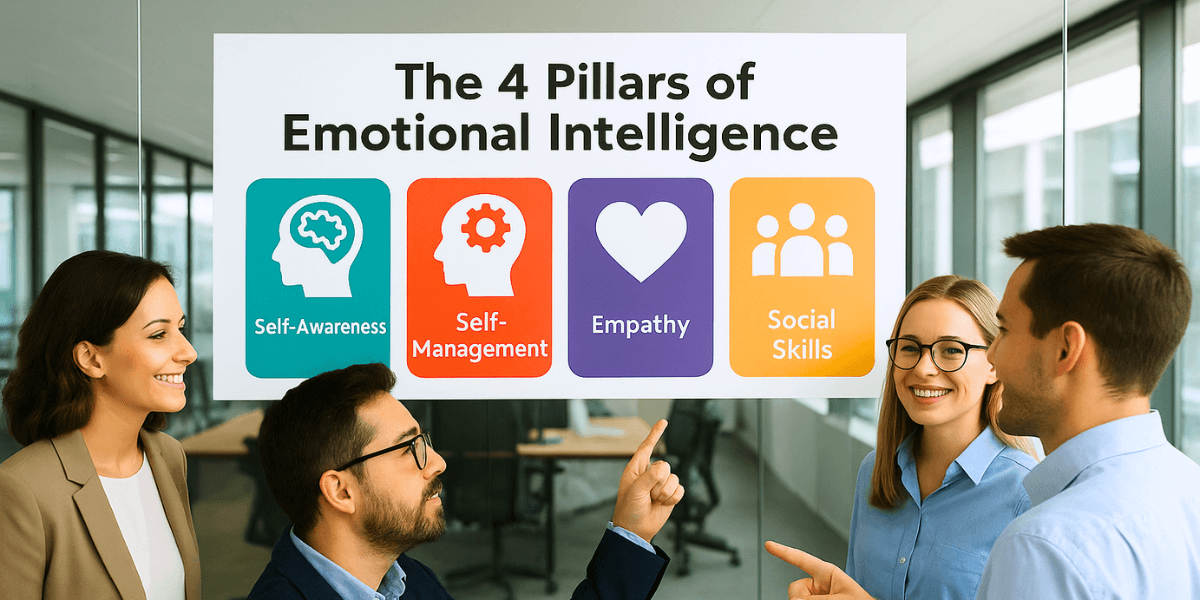Home > Emotional Leadership: Empower Your Team
What if your biggest management challenge wasn’t technical, but emotional? Between team tensions, stress, and lack of engagement, many leaders underestimate the power of emotional intelligence to transform their leadership. In this article, focused on emotional leadership, we’ll show you how mastering your emotions and decoding those of your team becomes a superpower to boost your team’s performance. You’ll discover concrete techniques to reduce turnover, build lasting trust, and unlock collective potential—even remotely!

Did you know that 90% of high-performing leaders master their emotions? Emotional intelligence is the ability to understand your own feelings and those of others. According to Daniel Goleman, it relies on four pillars: self-awareness, self-regulation, empathy, and relationship management. As confirmed in our analysis of the most sought-after soft skills, this competence radically changes how we manage teams.
Unlike IQ, EQ can be trained daily. A manager with high EQ resolves conflicts twice as fast! That’s why 74% of companies now include it in their assessments.
A study from HEC Paris reveals that teams led by emotionally intelligent leaders see an 18% increase in productivity. Take the example of this customer service team that cut its turnover by 40% in 6 months just by training managers in active listening.
| Key skill | Concrete signs |
|---|---|
| Social awareness | Recognize what’s left unsaid in meetings |
| Stress management | Stay productive under tight deadlines |
| Inspirational leadership | Unite people around a common goal |
Where does your managerial EQ stand? Start by reflecting on three recent situations: how did you respond to a conflict? To a heavy workload? To an innovative idea? Our proven team management methods show that a 5-minute weekly feedback session with each team member boosts engagement by 27%.
The secret? A virtuous circle: active listening → adapting your management style → tangible results. Ready to become an emotion detective?

The DESC method turns difficult conversations into opportunities for progress. Take the example of a stressed employee: “I see you’ve been working late for three days” (Describe), “I’m worried about your work-life balance” (Express), “Could you delegate two tasks this week?” (Specify), “That would help you focus on what really matters” (Consequences). A tech manager boosted team satisfaction by 35% using this approach.
A key warning sign? A sudden drop in meeting participation. The “emotional buffer” technique yields surprising results: five minutes of informal discussion before each key meeting opens up communication.
Five steps to provide kind yet firm feedback:
Physical space matters just as much as psychological climate. One startup set up “confidential corners” with cozy armchairs—and mediation requests dropped by 55%. The secret? Rituals that foster connection without pressure: themed monthly lunches, a shared success board…
Anonymous pulse surveys let you gauge your team’s mood in real time. But be careful not to replace people with numbers! A healthy balance? 70% in-person interactions, 30% objective data.

What if your meetings became idea incubators? De Bono’s “Six Thinking Hats” method works wonders: each participant takes on a different role (creative, critical, organizer…). The result? 63% more usable ideas, according to a recent study. The key? Creating a space where even the quietest voices feel free to speak.Remote and hybrid management
Managing a distributed team requires more than just good tools—it demands emotional availability. Trust doesn’t happen over Zoom; it’s built through regular, human interactions. One manager scheduled 15-minute informal check-ins every Friday: absenteeism dropped by 22%.
The era of the “hero leader” is over. Today’s impactful leadership is shared, adaptive, and horizontal. A recent McKinsey report shows that organizations with “networked” leadership models are 2.4 times more resilient in crises.

Great leaders never stop learning. Whether through coaching, peer feedback, or reading, they invest in their own evolution. One idea to start: write down your top 3 emotional reactions of the week—and ask yourself what triggered them.
Emotional leadership isn’t a soft skill—it’s a strategic advantage. By choosing to cultivate it, you become the kind of leader that teams want to follow—even in times of uncertainty.
And now, it’s your move: which of these techniques will you try first?
The real challenge? Maintaining human connection behind screens. A simple tip: dedicate the first 5 minutes of each video call to personal updates. Teams that do this see their collaboration rate increase by 40%.
| Solution | Optimal use |
|---|---|
| Anonymous emotional surveys | Gauge overall team climate monthly |
| Voice analysis AI | Detect stress during meetings |
| Shared mood boards | Track team mood in real time |
Beware of the fine line between transparency and information overload. A meta-analysis published in Heliyon shows that leaders who share 70% of relevant information gain greater team buy-in.
The secret lies in “fluid boundaries.” A Lyon-based SME reduced turnover by 25% by allowing employees to define their 3 peak focus hours per day. The key? Clear goals combined with real flexibility in execution methods.
And you—what will be your first step to turn change into a performance booster?

Your emotional learning journal is your best ally. Every evening, write down one meaningful interaction: what emotion did you feel? How did you manage it? One leader improved their EQ by 22% in 6 months thanks to this simple exercise.
| Skill | Mastery indicators |
|---|---|
| Self-awareness | Identify 3 emotions daily |
| Emotional regulation | Reduce impulsive reactions by 50% |
| Inspirational leadership | Encourage 1 idea per team member |
Your values are passed on through concrete details: how you welcome a new hire, how you react to mistakes… As taught in our strategy module, aligning words and actions is the key to credibility.
Reverse mentoring is gaining ground: juniors coach seniors on digital tools, creating a virtuous learning loop. One company saw a 40% increase in innovation with this approach.
Mesurez votre impact sur 3 ans grâce à des indicateurs clés :
Prêt à laisser une empreinte durable ? Votre héritage commence par le prochain feedback que vous donnerez.
Vous avez désormais les clés pour transformer votre leadership grâce à l’intelligence émotionnelle : comprendre les émotions, adapter vos pratiques managériales et stimuler l’intelligence collective. Passez à l’action dès demain avec un feedback constructif ou un rituel d’équipe – votre capacité à inspirer confiance et performance deviendra votre meilleur atout. Le leader de demain allume des étincelles, pas des incendies.

Quels sont les 4 types de leadership ?
Autoritaire (décision seul), démocratique (décision partagée), délégatif (autonomie), coaching (accompagnement). D’autres styles existent, mais le plus adapté dépend de l’équipe et du contexte.
Quelles sont les compétences clés de l’intelligence émotionnelle ?
Les principales : conscience de soi, maîtrise de soi, motivation, empathie, compétences sociales. On peut y ajouter : adaptabilité, assertivité, résolution de conflits, leadership, influence et optimisme.
Quels métiers demandent une forte intelligence émotionnelle ?
Management, RH, coaching, relation client, santé, accompagnement… Tout métier impliquant de la communication, de l’écoute et de la gestion humaine en bénéficie.
Quels sont les 5 axes de l’intelligence émotionnelle ?
Conscience de soi, maîtrise de soi, motivation, empathie et gestion des relations. Ce sont les fondations d’un leadership humain et inspirant.
Pourquoi l’intelligence émotionnelle est-elle essentielle pour un manager ?
Parce qu’elle permet de mieux comprendre ses collaborateurs, de désamorcer les conflits et de renforcer l’engagement. C’est une compétence clé pour fédérer une équipe, surtout en période d’incertitude.
Comment développer son intelligence émotionnelle au travail ?
Par l’observation de ses réactions, l’écoute active, le feedback régulier, et des outils comme le journaling ou les formations en soft skills. Cela s’apprend, comme un muscle à entraîner.

ITTA is the leader in IT training and project management solutions and services in French-speaking Switzerland.
Our latest posts
Subscribe to the newsletter

Nous utilisons des cookies afin de vous garantir une expérience de navigation fluide, agréable et entièrement sécurisée sur notre site. Ces cookies nous permettent d’analyser et d’améliorer nos services en continu, afin de mieux répondre à vos attentes.
Monday to Friday
8:30 AM to 6:00 PM
Tel. 058 307 73 00
ITTA
Route des jeunes 35
1227 Carouge, Suisse
Monday to Friday, from 8:30 am to 06:00 pm.